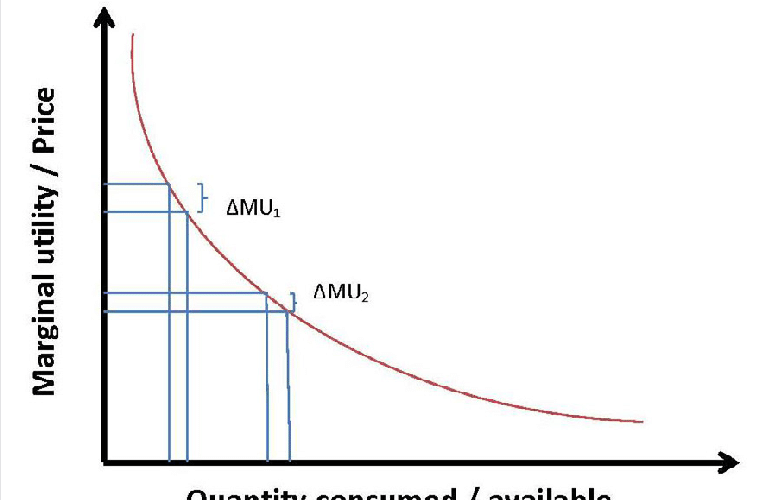The pleasure and delight we derive from consuming a product or service is referred to as utility. So when we eat dinner, we acquire utility, which may also be described as satisfaction. Having said that, the utility can vary. For example, eating at an expensive a la carte restaurant rather than Mcdonald’s may provide more utility. In other words, utility assesses our preferences as well as our willingness to pay for them. Knowing the marginal utility enables businesses to be aware of their clients’ contentment or enjoyment with a certain product. This is due to the fact that the level of fulfillment influences consumers’ future purchasing decisions. In this post, we’ll learn about the relevance of the metric, the many types and examples, and how to calculate marginal utility using the formula. We’ll also look at the law of diminishing marginal utility.
What Is Marginal Utility?
The increased satisfaction that a consumer gets from possessing one more unit of an item or service is known as marginal utility. Economists utilize the notion of marginal utility to determine how much of a product people are willing to buy.
Consumption of an additional item enhances total utility, resulting in positive marginal utility. Negative marginal utility, on the other hand, happens when the consumption of one extra unit reduces the overall utility.
Marginal Utility Analysis
Economists employ the concept of marginal utility to assess how satisfaction levels influence customer decisions. The concept known as the law of diminishing marginal utility has also been recognized by economists. It describes how the initial unit of an item or service has more utility than subsequent units.
Although marginal utility tends to diminish with consumption, depending on the good consumed, it may or may not ever approach zero.
The concept of marginal utility is useful in describing how customers make decisions to get the most out of their limited budgets. People will continue to consume more of a good as long as the marginal utility exceeds the marginal expense. The price in an efficient market equals the marginal cost. That is why consumers continue to buy more until the marginal utility of consuming equals the cost of the good.
Read also: WHAT IS MARGINAL COST: Formula, Calculations & Examples
Progressive taxation are frequently justified by the law of diminishing marginal utility. Higher taxes, the theory goes, result in less loss of utility for someone with a higher income. Money provides diminishing marginal utility to everyone in this instance. Assume the government needs to raise $20,000 from each individual to cover its expenses. If the average salary is $60,000 before taxes, the average person would earn $40,000 after taxes and live comfortably.
However, for anyone earning less than $20,000 to give over everything to the government would be unjust and would necessitate a significantly bigger sacrifice. This is why poll taxes, which require everyone to pay the same amount, are generally unpopular.
Furthermore, a flat tax with no individual exemptions that obliged everyone to pay the same percentage would disproportionately affect those with lower incomes due to marginal utility. A 33 percent tax would tax someone earning $15,000 per year into poverty, while someone earning $60,000 would still have around $40,000.
Marginal Utility Formula
The marginal utility formula used to calculate consumer satisfaction is as follows:
MU = Change in Total Utility/Change in Unit Count
Marginal Utility Formula
You can estimate the unit changes by subtracting the current units of utility level and consumption from the previous units.
How to Calculate Marginal Utility
Companies and people frequently utilize marginal utility calculations to assign a monetary value to their products and services. They use it to determine the success of a specific item and alter production accordingly. Although some businesses use complicated estimations to determine the measure, you can calculate it using the simple marginal utility formula shown above
Let’s go over the stages in detail to discover how to find the appropriate measurements.
#1. Determine the initial total utility.
A manager must first evaluate the total utility of a customer’s initial visit in order to get an average metric. Total utility is the level of consumer satisfaction that a product or service provides. To calculate total utility, add the prices a consumer is willing to pay for the first and each additional product.
#2. Find the second total utility.
Examine the data you have on the second visit. Spend attention to the amount of money a consumer is willing to pay for your products and apply the same strategy. To calculate the second total utility, add all of the prices together.
#3. Calculate the difference.
Once you’ve determined the total utility of the visits, gather them to calculate the difference. The result will be the measurement you need to use in the formula.
#4. Calculate the difference in the number of products.
After receiving totals, add up the items purchased on the first visit. Repeat for the second visit. Subtract the totals from one another to get the second measure — the amount of goods differential.
Let’s look at our example of marginal utility first to see where to begin.
Example of Marginal Utility
Let’s say an office worker is starving and decides to visit a bistro that serves veggie burgers. Although one vegetarian burger costs $3, this guest is willing to spend $6 for each. As a result, the utility value of one burger is $6.
The worker is eager to consume two burgers during their visit to the cafe. This person is willing to pay $4 for the second vegetable burger because they know they will be full after the first one. As a result, there will be lower utility costs. To calculate total utility, add the prices the worker is willing to pay.
- Total utility = $6 + $4 = $10
The worker wants to eat four burgers during his second visit to the cafe a month later. They decide that after paying $6 for the first vegetarian burger, the second burger is only worth $5 because they are no longer hungry. They would only pay $2 for the following burger once they finished the second.
2. Total Utility = $6 + $5 + $2 + $2 + $2 = $17.
Let us calculate the total utility difference: $17 – $10 = $7.
Difference in item quality = 5 – 2 = 3.
Let us now calculate marginal utility:
7 / 3 = 2.3 is the marginal utility.
As a result, the marginal utility demonstrates the level of enjoyment that a customer can acquire by consuming an additional product or service. When the price exceeds the consumer’s marginal utility, they cease purchasing new products.
Example of Three Common Types of Marginal Utility
Following on from the preceding example, here are the three types of marginal utilities:
#1. Positive Marginal Utility
It is the exhilaration (utility) gained as the number of units consumed increases. In Jane’s case, the more chocolate bars she received, the more she felt loved and valued. Each additional bar increased her marginal utility.
#2. Zero Marginal Utility.
When a consumer loses interest in ingesting the following additional unit. In the example of Jane, all ten of her friends brought her chocolate, assuming that each gift was offered in sequential order. Furthermore, none of her friends brought her a different type of gift. Economists suggest that the tenth bar of chocolate will be less exciting than the first, and she may grow tired of receiving gifts. Her marginal utility will have reached zero at this moment.
#3. Negative Marginal Utility
It happens when an excess of consumption produces harm or damage. In Jane’s situation, consuming more than two chocolate bars may lead her to become ill, putting an end to her desire to eat any more chocolates.
The Practical Use of Marginal Utility
The four most common applications of marginal utility are as follows:
#1. System of Progressive Taxation
The progressive taxation system is justified by marginal utility. A rational marginal utility deduction is the assumption that those with higher incomes pay more than those with lower incomes. A competing flat tax rate system is burdensome to lower-income taxpayers because the marginal cost exceeds the marginal utility.
#2. Consumer Behavior in Goods Consumption
Consumers will pursue things that they believe will provide them with higher marginal utility. A well-informed organization will recognize market trends and provide more utility.
#3. Executive Decision on Goods Pricing
Assume a restaurant offers two types of pizza: Margherita and Mexican Green. Over time, management discovers that its clients have a stronger affinity for Mexican Green Pizza. Using the marginal utility deduction, the restaurant should raise the price of Mexican Green Pizza.
#4. Product Development
The law of marginal utility is well understood by automobile manufacturers. For example, if a particular vehicle model performs well in the market, the manufacturer would normally add new features to better position it in price and to sustain sales volume.
What Is the Law of Diminishing Marginal Utility?
According to the law of diminishing marginal utility, as consumption increases, the marginal utility obtained from each extra unit decreases. The marginal utility is the incremental increase in utility that arises from consuming one more unit. “Utility” is an economic phrase that means “satisfaction or happiness.”
Example of Diminishing Marginal Utility
A person can buy a slice of pizza for $2 and is very hungry, so they decide to buy five slices of pizza. After that, the individual consumes the first piece of pizza and derives some utility from eating it. The first slice of pizza has a high benefit because the individual was hungry and this was the first food he ate.
The individual’s appetite is being fulfilled after swallowing the second slice of pizza. Because they were not as hungry as before, the second slice of pizza provided less benefit and delight than the first. The third slice, like previously, has even less utility because the individual is no longer hungry.
The marginal utility of the fourth slice of pizza has also decreased, as it is difficult to consume due to the individual’s discomfort from being full from food. Finally, the fifth slice of pizza cannot be eaten. The individual is so full from the first four slices of pizza that consuming the final slice has a negative utility.
The five slices of pizza represent the decreasing utility that is felt after consuming any good. In a business setting, having three accountants on staff may be advantageous. However, if there is no need for another accountant, hiring another accountant reduces utility because the new job provides just a minimal advantage.
Applicability
The computed marginal utility can be used in a variety of ways. Here is a partial list of some of them:
- The progressive tax is based on the diminishing utility idea. The term “progressive taxation” refers to the increase in the average tax rate with the increase in the amount of taxable income, so that the burden of paying high taxes falls on those with greater income and those with lower income can be relieved of the burden.
- Consumers would prefer products with greater MU since they would never waste their money on anything that would fail to match their expectations in the long run.
- The price of a thing is determined by its utility. For example, things that provide greater happiness over time and after the first use are priced higher to maximize profits. It becomes a roadmap for brands to improve customer retention as the latter learns how to enhance and maintain the product or service to ensure customer happiness. This, in turn, ensures customer loyalty to the brands and ensures that their word-of-mouth referral draws in a new group of consumers, assisting firms in building a stronger client base.
Total Utility vs. Marginal Utility
The two most popular words used to calculate consumer satisfaction when they pay for a product/service are marginal utility and total utility. Let us examine the distinctions between the two:
Total utility is the total enjoyment that a consumer receives from using a product or service. MU, on the other hand, is the level of satisfaction provided to customers by each unit of goods consumed.
The total utility of a product increases with time, whereas MU decreases as the number of units used increases.
What Is the Law of Declining Utility and Marginal Utility?
According to the law of diminishing marginal utility, a good or service’s marginal utility decreases the more of it is used by a person. Consuming increasing quantities of a good gives economic actors less and less pleasure.
What Is the Law of Declining Utility and What Does It Look Like?
The phenomenon known as diminishing marginal utility describes how each extra unit of gain results in an ever-smaller rise in subjective value. For instance, three sweet bites are preferable to two, but the twentieth bite does not significantly improve the experience past the nineteenth (and could even make it worse).
How Does the Law of Diminishing Returns Work?
An economic principle known as the law of diminishing returns states that as an investment in a certain area increases, the rate of profit from that investment can no longer increase at a certain point assuming other variables remain constant.
How Significant Is Marginal Utility?
This law aids in the understanding of how customers might come to an equilibrium for a single commodity in economics. Most of the time, a consumer can use a good until the marginal utility equals the selling price, guaranteeing them the highest level of satisfaction.
Marginal Utility FAQs
What is diminishing marginal utility?
Diminishing marginal utility is an economic law that is significant in shaping consumer preferences.
What is the formula of marginal utility?
Marginal Utility = Change in total utility/Change in number of units consumed.
What is marginal utility with example?
If you buy a can of juice and then another, the marginal utility is the utility gained by the second can of juice






